The 42 Letter Name by Robert Kirschbaum
God’s Names. What an odd notion. And yet they provide us with a means of knowing Him better and, simultaneously, distancing us from the unfathomable enormity of His essence. The Bible ascribes approximately nine appellations, including “Lord,” ‘The Tetragrammaton” and other variants of the name “God.” Later the Rabbis evolved another nine names, all of which are references to His attributes such as Master of the Universe or the All-Merciful. Curiously two names are only references to the number of letters that make up the otherwise mysterious and unpronounceable name; the 12-letter Name of God and the 42-letter Name of God (Kiddushin 71a). The 42 letter Name of God is found in the 42 words of Ana B’koach, the mystical prayer ascribed to the Tanna R. Nechuniah ben Hakanah included in portions of our daily prayers. It would appear that this name was used in the Priestly Blessing in the Second Temple (Schiffman: Institute of Jewish Studies, 1973; pg. 98). Additionally medieval Jewish mysticism and philosophy conceived of a 45-letter Name of God and a 72-letter Name of God. Many, including Judah Halevi and Maimonides, consider HaShem as the only real Name of God, the others only descriptions of attributes. Whatever our opinion, we approach God’s names with awe, respect and affection.
The artist Robert Kirschbaum has harnessed an ancient tradition found in the Gemara that tells us there is a creative power in the letters of the Name of God. “Rab Judah said in the name of Rab: Bezalel knew how to combine the letters by which the heavens and earth were created…” (Berochos 55a). Out of this and other sources such as the Sefer Yezirah came the belief that by using the letters of the Name of God a trained mystic could create from a lump of clay an artificial man, a golem. In Sanhedrin 65b it is stated “R. Hanina and R. Oshaia spent every Sabbath eve in studying the ‘Book of Creation’ [and the Names of God] by means of which they created a third-grown calf and ate it.”
Kirschbaum has more modestly created a limited edition artist’s book containing 42 abstract prints, white lines on a black field, that reflect his contemplation and evocation of the 42-letter Name of God. He took an abstract construct, what for an artist is a proverbial lump of clay, and made it tangible as a three-dimensional idea and then abstracted it yet again into a two-dimensional drawing. His lump of clay was a nine square grid, which he then mentally made into a cube defined as an axonometric projection where the parallel lines never converge (Number 43). This concept related to notions of infinity and the complexity of God, the cube’s lines theoretically radiating in all possible directions. More satisfyingly, the cube was simultaneously abstract as a concept and concrete as a physical drawing: just like a Name of God is a concept, i.e. not God Himself, and concrete in that the word possesses sanctity in its physical form. Once he had this concept firmly in mind he proceeded to create 42 drawings that dissect various aspects of this cube, always keeping the structure subliminally present, viewing each fragment from the same perspective to constantly affirm the whole, just as a specific name of God never denies any of myriad other aspects of the Divine. He created a holy sculpture rendered as a two dimensional revelation.
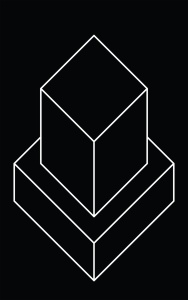
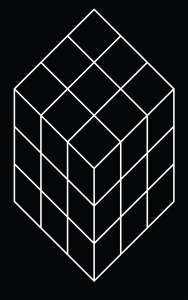
This project rests precariously on the edge between the Conceptual and Abstraction, resisting any attempt to be claimed as exclusively either. As Kirschbaum started working the resulting line drawings did not necessarily resemble aspects of a nine square cube. Working with a deliberate arbitrariness some of the images emerged echoing physical objects; a portal, corners of an altar, steps to a Temple; all visual meditations on the cube that morphed into holy objects of the Temple itself. Locating his exploration in the place of the Temple the artist defines this Name of God as being inextricably linked with the place of God’s presence and the place where we could meet Him. Kirschbaum declares that in “The 42 Letter name I seek to link the Creation–an act of divine construction–with the Temple as a model of the universe.” Other images emerge either as abstract shapes or as objects, like tefillin seen in Number 20, creating multiple visual concepts operating in Talmudic simultaneous conversation with each other. Rather surprisingly like the world of the Talmud, the drawings became more self referential, exploring their internal logic as another means of exegesis. He occasionally renders some parts of the objects as flat or arbitrarily erases or connects lines that contradict the internal structure of the cube.
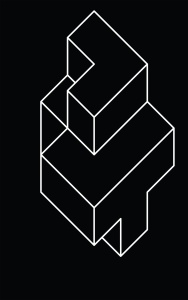
Creating such wonderful visual effects defy the logic of the cube construct and yet compel the viewer to think aesthetically. The imagined cube, somehow more real than the mundane world, becomes an uncharted arena for an intellectual, creative and aesthetic adventure.
Charting the permutations of abstract shapes mysteriously hidden inside a nine square cube begins to approximate mystical meditations on Hebrew letters, their shapes, theological implications and textual repercussions emerging in unexpected visual patterns. Number 2 at first seems simple, allowing one to imagine what pieces of the cube have been removed. But then we notice that you can read the lines on the left side independently and imagine an entire middle section as empty and bounded by lines alone.
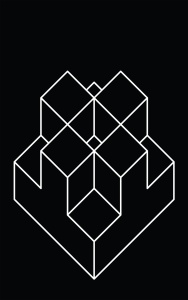
At times the cube can seem especially cube-like, as in Number 9, presenting five voids in the heart of the cube. Then with a blink of an eye that shape becomes a flat pattern that takes on a life of its own. In another apparition,
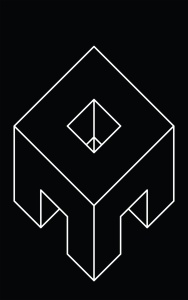
Number 14, we can suddenly see inside the cube, looking down into its innards like an aerial view of a house with a central courtyard.
In order to fully appreciate what we are seeing it is crucial to continue to refer back to the original conception, which in this series becomes Number 43. Every aspect of these meticulously produced prints is meant to summon echoes of an abstract idea and a process; whether it is a meditation on how some of the pieces fit into one another, reflect the negative space of something else or the concept that in order to make these images the artist had to simultaneously have the complete cube in his mind at all times, even as he slowly carved away portions revealing unexplored visual riches.
Kirschbaum’s 42 Letter Name project has been preceded by years of work with Jewish subject matter. Recently he did a series of mixed media drawings and pigmented ink jet prints on the Akeidah. These explore, again in abstract form, the complexities of the underlying theology of Abraham’s most arduous test also located at the site of the Temple. Starting in 1990 Kirschbaum produced a brilliant series on Portals, a meditation on the structure of sacred entrances to Jerusalem and the Temple itself. His works later in the 1990s pondered abstract images of the Temple Mount and the geographic placement of the Temple, called Squaring the Temple.
One of the most intriguing aspects of Robert Kirschbaum’s works is his insistence on an abstract vocabulary to depict Jewish concepts. In his written statement on the Akeidah series he comments about creating an image of a sacred space: “Recognizing that this work of architecture is the single most potent image in a religion that eschews representation, I have undertaken to explore the symbol of the Temple within strictures imposed by the second commandment.” In his manner he is perhaps the most observant and conservative of contemporary Jewish artists.
Kirschbaum’s 42 Letter Name project takes to heart the essential aspects of our interaction with God’s Name: “May His great Name grow exalted and sanctified,” and our constant communal response “May His great Name be blessed forever and ever.” By visually examining, exploring and creating his abstractions, the artist does just that.